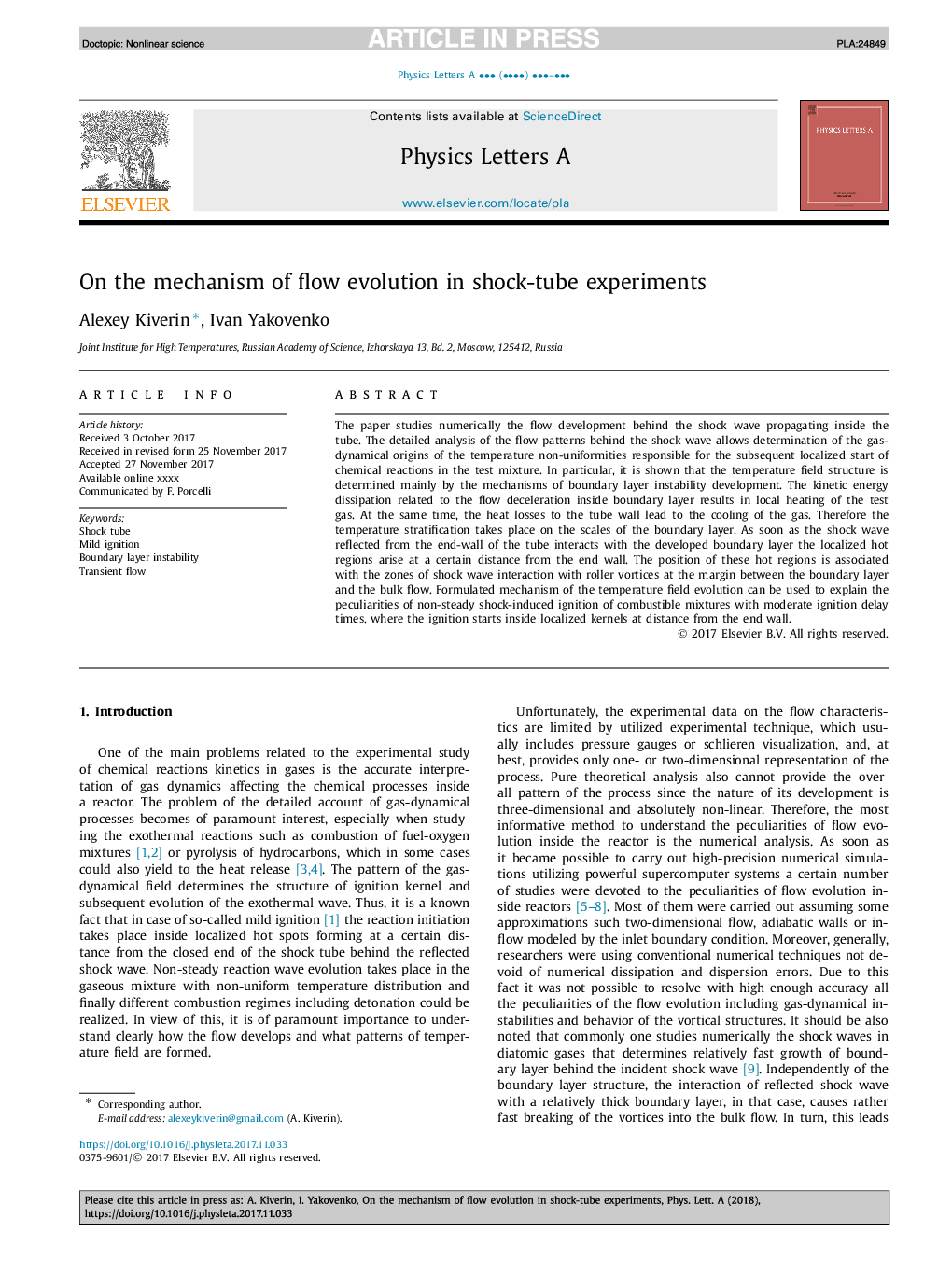| کد مقاله | کد نشریه | سال انتشار | مقاله انگلیسی | نسخه تمام متن |
|---|---|---|---|---|
| 8204169 | 1530535 | 2018 | 6 صفحه PDF | دانلود رایگان |
عنوان انگلیسی مقاله ISI
On the mechanism of flow evolution in shock-tube experiments
ترجمه فارسی عنوان
در مکانیزم تکامل جریان در آزمایشات لوله شوک
دانلود مقاله + سفارش ترجمه
دانلود مقاله ISI انگلیسی
رایگان برای ایرانیان
کلمات کلیدی
لوله شوک، جرقه خفیف، بی ثباتی لایه مرزی، جریان گذرا،
ترجمه چکیده
این مقاله به صورت عددی جریان توسعه در پشت موج شوک منتشر شده در لوله را بررسی می کند. تجزیه و تحلیل دقیق الگوهای جریان در پشت موج شوک اجازه می دهد تا تعیین ریشه های گاز پویا از عدم تنوع درجه حرارت ناشی از شروع واکنش بعدی واکنش های شیمیایی در مخلوط آزمون. به طور خاص، نشان داده شده است که ساختار درجه حرارت به طور عمده توسط مکانیسم توسعه بی ثباتی لایه مرزی تعیین می شود. اتلاف انرژی جنبشی در ارتباط با کاهش سرعت در داخل لایه مرزی، باعث گرم شدن موضعی گاز آزمایشی می شود. در عین حال، تلفات گرما به دیواره لوله منجر به خنک سازی گاز می شود. بنابراین طبقه بندی درجه حرارت در مقیاس لایه مرزی رخ می دهد. به محض اینکه موج شوک منعکس شده از دیواره انتهایی لوله با لایه مرزی توسعه یافته، مناطق گرم و محلی ایجاد شده در فاصله ای معین از دیواره انتهای آن بوجود می آیند. موقعیت این مناطق گرم با مناطق تعامل موج شوک با گردابهای غلتکی در حاشیه بین لایه مرزی و جریان انباشته ارتباط دارد. مکانیزم تهیه شده از تحولات دماهای دمایی می تواند برای توضیح ویژگی های احتراق ناشی از شوک ناشی از مخلوط های قابل اشتعال با زمان تاخیر خوردگی متوسط، که در آن جرقه در داخل هسته های موضعی در فاصله ای از دیواره انتهایی، توضیح داده شود.
موضوعات مرتبط
مهندسی و علوم پایه
فیزیک و نجوم
فیزیک و نجوم (عمومی)
چکیده انگلیسی
The paper studies numerically the flow development behind the shock wave propagating inside the tube. The detailed analysis of the flow patterns behind the shock wave allows determination of the gas-dynamical origins of the temperature non-uniformities responsible for the subsequent localized start of chemical reactions in the test mixture. In particular, it is shown that the temperature field structure is determined mainly by the mechanisms of boundary layer instability development. The kinetic energy dissipation related to the flow deceleration inside boundary layer results in local heating of the test gas. At the same time, the heat losses to the tube wall lead to the cooling of the gas. Therefore the temperature stratification takes place on the scales of the boundary layer. As soon as the shock wave reflected from the end-wall of the tube interacts with the developed boundary layer the localized hot regions arise at a certain distance from the end wall. The position of these hot regions is associated with the zones of shock wave interaction with roller vortices at the margin between the boundary layer and the bulk flow. Formulated mechanism of the temperature field evolution can be used to explain the peculiarities of non-steady shock-induced ignition of combustible mixtures with moderate ignition delay times, where the ignition starts inside localized kernels at distance from the end wall.
ناشر
Database: Elsevier - ScienceDirect (ساینس دایرکت)
Journal: Physics Letters A - Volume 382, Issue 5, 6 February 2018, Pages 309-314
Journal: Physics Letters A - Volume 382, Issue 5, 6 February 2018, Pages 309-314
نویسندگان
Alexey Kiverin, Ivan Yakovenko,
